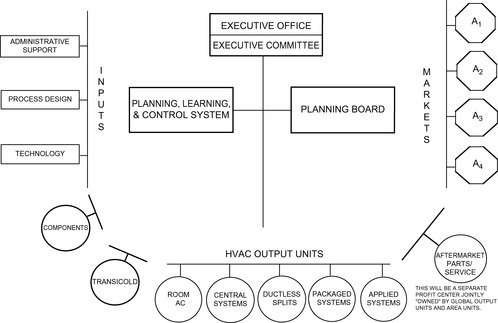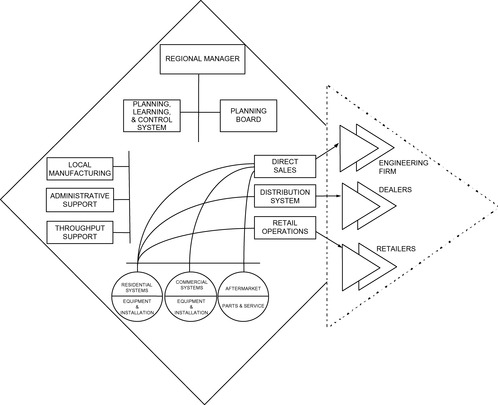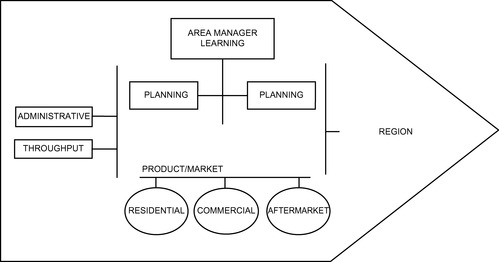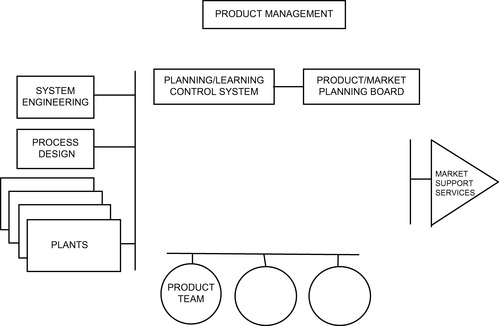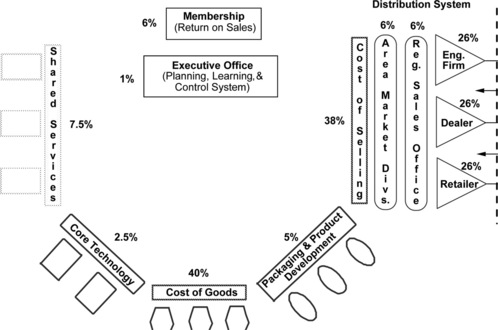Chapter froteen. Carrier Corporation
The challenge for Carrier was to create a system out of an aggregate of more than 90 autonomous operations. The question was how to integrate and differentiate a global operation so it could be both centralized and decentralized at the same time. Carrier had to revitalize its core technology, manage its interactions with a patchwork of semi-autonomous manufacturing units spread all over the world, and become cost competitive in many highly competitive markets, despite having a huge network of aging distributors who were unwilling to learn the implications of new technology. This document summarizes the first iteration of design based on the noble notion of target costing and delivery of value (benefits/costs) at all levels of the chain. The process starts by defining benefits at the end of the chain (the end user) and working backward to the manufacturer.
Keywords: Air cleaning devices, Architects, Building material, Climate control, Component suppliers, Compressors, Contractors, Controls, Cross discipline knowledge, Decision system, Design cycle, Duct-free splits, Environmental concern, Franchise, Heat transfer, Hybrid-distribution, Industry benchmarks, Insulation, Intolerance of incompetence, Low technology, Maturation, Measurement and reward system, Miniaturization, Motors, Orbital motions, Performance centers, Process technology, Product technology, Refrigerants, Sensors, Strategic alliances, Systems architecture, Target costing, Variable budgeting
I got the opportunity to work with Carrier Corporation when Professor Tom Lee and Gerald L. Wilson of MIT asked me to make a presentation to Karl J. Krapek, then the CEO of Carrier Corporation. I was told that I would be paid for the full day, but that if Mr. Krapek interrupted me to make a phone call I should assume that the presentation was over. Although this seemed a little awkward, it somehow challenged me. Oddly enough, fifteen minutes into the presentation, Karl wanted to make a phone call. I collected my papers, assuming the session was over, but much to my surprise he asked me if I could give him ten minutes to get a few of his colleagues to join us. He wanted them to hear what I had just said. A full-day presentation led to a contract and a redesign project for Carrier.
The challenge for Carrier was to create a system out of an aggregate of more than 90 autonomous operations. The question was how to integrate and differentiate a global operation so it could be both centralized and decentralized at the same time. Carrier had to revitalize its core technology, manage its interactions with a patchwork of semi-autonomous manufacturing units spread all over the world, and become cost competitive in many highly competitive markets, despite having a huge network of aging distributors who were unwilling to learn the implications of new technology.
This document summarizes the design produced by a 15-member design team consisting of Karl J. Krapek and his direct reports in several sessions during the fourth quarter of 1992. Ali Geranmayeh from INTERACT was my associate in this project.
This is an idealized design. Its content, at this stage, is tentative and subject to change. Implementation of this design requires planning. Because of changes in the corporate environment and a shift in strategy, implementation of this design was not attempted. Nevertheless, it represents a state-of-the-art design based on Carrier's original intent.
14.1. Expectations, assumptions, and specifications
Carrier is not just a manufacturer of equipment. We are designers, producers, and distributors of climate control systems. We own different parts of the value chain in different parts of the world. Regardless of ownership, however, we must understand the desires and needs at various levels of the chain.
From Carrier's perspective, all the actors and participants in the value chain, from the producer to the end user, are considered customers. They may be classified as follows:
• Distributors
• Dealers
• Consulting Engineers
• Contractors
• Retailers
• End users
We must deliver value (benefits/costs) at all levels of the chain. But we must start defining benefits at the end of the chain (the end user) and work our way backward to the manufacturer. Value comes from the total package:
• Performance
• Price
• Service
• Installation
Significant opportunities for creating value for the end user exist in understanding the latent needs and desires of customers.
14.1.1. The Changing Game: In General
• FROM mass production based on economy of scale and reliability of forecasts TO flexible production based on a low break-even point and rapid change of products.
• FROM management of independent variables with separate solutions TO management of interdependent variables with integrated solutions.
• FROM generation of knowledge as the basis of competitive advantage TO operationalization of new knowledge as the basis for competitive advantage.
• FROM sole reliance on product technology TO investment in process technology.
• FROM target pricing, taking price as the controllable variable, TO target costing with cost as the controllable variable.
• FROM regarding labor as a variable cost and considering dispensable cheap labor as a competitive advantage TO regarding labor as a fixed asset and considering knowledgeable workers as a sustainable advantage.
14.1.2. The Changing Game: The HVAC Industry
• Emergence of strong (independent) component suppliers —their large scale and focused scope give them the capability to eventually control key components that comprise much of the cost, technology, and basis for differentiation of final products. They also pose a threat as potential competitors in the end-products market.
• Emergence of “no frills” competitors offering very low prices. These are low-technology, low-cost companies with nimble and lean operations.
• Japanese competitors combine operational effectiveness with high-technology products. Their likely strategy will be to:
• Concentrate on the lower end of the market (a growth sector).
• Offer easy-to-use, fully engineered packages requiring little maintenance.
• Sell directly to retailers, bypassing the distributors.
• Then move up to larger products, relying on engineers and architects to sell.
• Integration of electronic controls is becoming a must.
14.1.3. Drivers for Change
• Environmental concerns
• Maturation of large markets and emergence of new ones
• Increasing discrimination and differentiation by customers
• Globalization of competition
• Miniaturization (size of products, material weight and bulk)
• New technologies (e.g., in heat exchange and transfer)
• Duct-free splits change the traditional structure of the value chain
14.1.4. Bases for Competition
• Delivery
• Cost
• Size
• Time to market
• Service
• Distribution
• World-class manufacturing processes
14.2. Core values
We will create wealth throughout the chain from the supplier to the end user. We take responsibility for creating win/win situations to dissolve conflict among players at various levels of the chain. We take total responsibility for the entire system all the way to the end user. The Carrier name backs the product, guaranteeing it all the way down the chain. Even if we do not own pieces of the chain, and even if the product is a private label, we guarantee proper functioning of what the customer buys (product and service). No excuses.
• Our commitment is to total customer satisfaction.
• We value excellence through knowledge. We promote intolerance of incompetence.
• We are committed to providing clearly communicated rules of the road and expectations of performance.
• We will be undisputed leaders in core technologies.
• We will be a mutually supportive interdependent system.
• We will invest in our employees, distributors, and dealers.
• We will influence the industry.
• No one will lose his/her job at Carrier as a result of circumstance, plant closings, departmental restructuring, or market downturns.
Three main questions are to be answered in this section:
1. Whose problems are we trying to solve?
2. What solutions are we providing to them?
3. How will we deliver the solution to those with the problem?
The first question deals with market segmentation, the second with product line offerings, and the third with access mechanisms. The business can be understood in terms of the cube formed by these three dimensions. Each dimension is considered in more detail in the following section.
14.2.1. Products and Services
We will use the following criteria for deciding whether to participate in a particular segment of the product line:
• Is the product a requirement for global leadership in climate control?
• Will the product help us compete more effectively from a strategic point of view? (Strategic concerns may be defensive, such as helping to keep our distributors/dealers loyal to us by providing them with a broad line of products; or offensive, such as discouraging competitors from going after our distributors/dealers, utilizing our distribution channel to move products made by others, or reducing costs due to economies of scale and scope.)
• Are there opportunities for utilizing our assets? From time to time we may selectively choose to participate in segments where there is no long-term strategic advantage but opportunities for utilizing our assets. We will not make new investments in such segments.
• Is this an opportunity to broaden the breadth of the line? A wide range of products is important to us because (1) it helps us win and maintain the loyalty of our distribution network and (2) it helps us leverage our technology and reduce our costs. In addition, a broad product line is an important defense against smaller competitors “niche-ing” us out of various market segments, and it helps support dealers and distributors in down cycles. A financially strong and loyal distribution network is a significant barrier to entry for would-be competitors.
The following obstructions in the current state of the industry provide significant opportunities for product/service offerings:
• The basic problem of climate control is not solved very well: people in large buildings are either too hot or too cold and they cannot easily manipulate the controls; in residential buildings the draft bothers people and stiff necks are common.
• There is no integration or cooperation between us and other actors controlling major elements of the building that affect the overall performance of the climate control system — insulation, windows, building materials, architects, and so on (in automobiles, climate control people must work very closely with glass, especially windshield, manufacturers).
14.2.2. Core Technology and Know-How
• We must have system design capability in all aspects of our business. In addition, we must have the following core components (in order of importance):
• Compressors
• Electronic controls
• Heat transfer devices
• Enclosures: shape and configuration; aerodynamic content and capability; and the fan
• Motor
• Diesel engines
• Air cleaning devices
• We must develop technical capabilities to integrate controls and motors (e.g., to generate orbital motion, and use refrigerants to cool the motor and the electronics inside it). United Technologies Corp. (UTC) has a motor supplier company. Can we work with them?
• We must have design capability for electronic control systems (including sensors). We can continue to buy components off the shelf. Partners are desirable to get the best electronic design capability.
• We will develop cross-disciplinary knowledge at every level of the engineering organization. An understanding of environmental trends and changing customer needs (both manifest and latent) will accompany this knowledge to ensure that innovative products reach the marketplace in a timely manner.
• A significant competitive advantage exists in the effective integration of disciplines through modeling. To accomplish this, we will encourage modeling through incentives and mentoring. Time constraints must be balanced with the need to learn by documenting and refining models after the design effort is complete. New engineering talent with disciplinary skills must be trained to think cross-functionally and the build and test culture must be replaced with a scientific predictive modeling culture.
14.2.3. Sales and Distribution System
• Our basic approach is a commitment to customer satisfaction: we will guarantee the satisfaction of the end user with all our products.
• We must develop dealer and distributor agreements such that we create partnerships throughout the value chain. We will need to rely heavily on them to a large extent to help us deliver our guarantee.
• Our guarantee applies to the system as a whole. Therefore, we must be able to:
• Produce the critical elements of the system (e.g., A/C unit).
• Specify minimum standards for all other elements to be used by our dealers (our differentiating factor).
• Buy and distribute noncritical items (e.g., duct work, coils, and thermostats) through our dealer system — but always give them the choice to obtain them elsewhere (so long as they meet standards); we supply through our “trading company.”
• We will treat our distributors/dealers “almost as franchisees.” We hope to get the cooperation level of a franchisee relationship without the legal hassles.
• Compliance with standards will be a major part of our dealer agreements.
• A loyal and efficient distribution network is essential to our leadership in the marketplace. We will have to create win/win situations in which our dealers and distributors remain financially healthy.
• We will have a hybrid distribution system: some company-owned distributors and some independents. We will own distributors when:
• We can meet the cost of capital of our investment.
• Ownership is strategically important to us.
• We have no other presence in the region.
• We will actively develop and utilize independent distributors in cases where their strong relationships with local dealers and customers cannot be duplicated by us.
• Irrespective of whether a distributor is independent or company-owned, we want them to be successful businesses in their own right and to work very closely with Carrier as a partner.
• We must be customer-focused. This implies sensitivity to geographical and national differences: understanding the needs of Latin American residents as well as those of North American residents (homes in Japan and homes in the United States versus rooftop and room A/Cs).
• Our marketing challenge is to find solutions for specific segments and applications.
• We must continually strive to drive costs out of the chain. We will achieve this through improved logistics, reduction of inventories, and lean manufacturing. These improvements will enable us to reduce the number of steps in the chain over time.
14.3. Systems architecture
14.3.1. Desired Characteristics
• A customer focus.
• Well-understood rules of the road and expectations of performance, with explicit decision criteria.
• Respect for the need for a control system to assure accountability, thereby allowing effective decentralization: supervision is a waste.
• Effective processes for dissolving internal conflicts. There are no conflict-free organizations. Those that can deal with conflicts constructively can use them as the engine for the system's vitality.
• Throughput-oriented rewards (not functionally oriented). Such incentive systems help dissolve structural conflicts while functionally oriented ones create them.
• One integrated solution for problems of reducing cost and waste, compressing time, increasing flexibility, and improving quality (as opposed to different solutions for each one).
• Lean, simple, nonbureaucratic, and flexible organization with easy communication up and down.
• Few written rules and procedures with formal and informal organization “in synch.”
• Empowerment at the lowest level (authority matching responsibility).
• Time sensitivity and awareness of the pressures of external competition.
14.3.2. A Multidimensional Framework
A multidimensional architecture employed in the following design recognizes the necessity for achieving competitive advantage in all three dimensions — market, product, and technology — at the same time. It therefore seeks to eliminate suboptimization around any one dimension. The objective is to actively generate synergy, latency, and efficiency by creating a win/win relationship among the three dimensions. A three-dimensional architecture recognizes the need for centralization and decentralization, integration and differentiation, and interdependency and autonomy at the same time.
In a three-dimensional architecture, structural conflicts inside the corporation are dissolved by incorporation of market mechanisms as the basis of interactions among different units wherever possible. The architecture, however, provides only the hardware for the system; business processes provide the software.
Carrier's architecture must be designed to support equal emphasis on markets, products, and technology. The architecture that follows will be used to accomplish this multidimensional focus while creating a market-driven business.
The predominant strategic thrust of Carrier Corporation is a strong market orientation and responsiveness to customers. The organization will be flexible enough to adapt to internal and external changes, stimulate continuous improvements in the quantity and quality of its outputs, and be able to learn rapidly and effectively. The systems architecture described (Figure 14.1) is intended to facilitate the pursuit of this strategy. It will support equal emphasis on markets, products, and technology, while creating a market-driven business.
14.4. Markets
Marketing functions in Carrier will be carried out in four semi-autonomous areas. Each area in turn will manage a number of regional units.
14.4.1. Regional Units
A region is the basic unit of the market dimension. It is where Carrier actually happens.
• The size and boundaries of a given region are determined by the following considerations:
• Physical access
• Climate
• Construction practices (design and material)
• Stages of economic development
• As the sole marketing arm of the Carrier Corporation, regional managers are relieved of their manufacturing responsibilities. Exceptions will be for some local factories designed to serve local markets only.
• Regional units will be sales and distribution service organizations. They will be primarily responsible for selling, distributing, installing, and servicing products. They will include application engineering and technical support.
• Regional units will have the responsibility to develop and maintain the distribution system in each region. The distribution system will comprise three main channels: direct, retail, and dealers.
• The sales organization in the field will be connected to plants and product groups by three vital processes:
• Product design cycle (requirements of the customer communicated to designers)
• Order payment cycle
• Logistics support
• Regional units have the primary responsibility for understanding the end users' requirements and helping Carrier provide appropriate solutions to those requirements.
• Regional organizations will be responsible for creating synergy at the local level and reducing unnecessary duplication of services. Since the nature of the problems and opportunities is different in each region, the organizational setup appropriate for each region will also be different in each region.
• Each region will also have a regional advocate who will be responsible for the development of new businesses that satisfy the needs of each region.
Figure 14.2 provides an example of how regional units may be organized to optimize market access and user concerns.
14.4.2. Area Units
Every area unit will be responsible for designing, engineering, and marketing a system of products and services as solutions to the needs of a given market segment. Initially, there will be three such segments in each area: residential systems, commercial systems, and industrial and institutional systems.
As market-driven units, area units must understand the current and latent climate control problems faced by specific market segments and develop and offer solutions to those problems.
Each unit will be responsible for system development in its specific segment. System designs will be informed by local requirements in different regions. System solutions will be designed on global platforms developed by output units. These platforms provide modular designs that standardize chassis and components while allowing for variations to satisfy different local requirements. Each output unit will have top system engineers on their team for developing global platforms within which local products can be manufactured.
Area units will develop the basic policies and approach for developing and maintaining a distribution system to serve all Carrier units. For example, area units will be expected to develop policies for acquiring and distributing complementary products intended to help increase the business at the dealership level. Implementation of policies will be the responsibility of regional units. Additionally, area managers will be responsible for developing new markets, for liaison between regional units and output units, and for consolidation and administration at the area level.
In general, area units will have no fixed assets. This will ensure that they are not preoccupied with existing facilities and current products. Their total focus should be on delivering the best solution to the customer.
These products and services may or may not be provided by Carrier manufacturing units. This constant examination and re-evaluation of the “make or buy” decisions will keep continuous competitive pressure on both the designers and the manufacturers (suppliers).
There will be members of the parts unit in each area to manage the logistics, warehousing, and physical transportation systems at the area level.
Figure 14.3 provides an example of how area units may be organized.
14.5. Output units
Output units will be responsible for the design and production of global end products. Such products are sold in more than one geographic region, have a high level of complexity, and offer significant economies of scale. Output unit managers will have worldwide responsibility for designing manufacturability, functionality, and serviceability, as well as lean production systems, delivery, and costs.
Global products will be designed on a global platform concept, that is, a modular design that standardizes chassis and components while allowing for variations to satisfy different local requirements. Carrier products must be globally conceived and designed. Carrier technology must be globally applied.
Output managers will be responsible for optimizing manufacturing facilities on a global basis to ensure competitiveness.
In the first approximation to the design, manufacturing resources will be optimized on an area basis. This will not mean, however, that each area will be expected to be self-sufficient from a manufacturing perspective. In fact, each area will be expected to develop at least one facility as a global supplier of products and become the champion of a global product.
Each output unit will be a profit center with the ability to sell and source externally. In addition, there will be two other output units: Transicold and Aftermarket Parts. The unique nature of the transportation product business necessitates treating it as an output unit separate from stationary HVAC (heating, ventilation, air conditioning) products. Transicold will continue to operate as it currently does; however, it will proactively seek to utilize the services offered by the existing Carrier sales and distribution system.
Aftermarket parts are important elements of our total solution to customer problems and also a big market opportunity. We must aggressively develop these businesses. Aftermarket parts will be a global business unit jointly owned by area (market) units and output units. It will buy and distribute Carrier and non-Carrier parts and components.
Figure 14.4 provides an example of how an output unit may be organized.
14.6. Components
The components group will be responsible for:
• Developing and maintaining state-of-the-art knowledge (product technology and design) for all of the previous categories.
• Manufacturing as many Category 1 products as is economically feasible.
• Seeking and creating partnerships to maintain strategic control over those Category 1 components that it cannot economically produce.
• Creating strategic alliances with producers of Categories 2 and 3 to ensure sufficient influence over the developments and reliable sources of supply.
To ensure worldwide cost and quality competitiveness, each component business should be able to survive on a stand-alone basis. Therefore, each unit in this group will be treated as a separate business. Units within the components group will have the option of selling their products to other original equipment manufacturers (OEMs). Likewise, Carrier product managers will have the option of sourcing their components from external suppliers.
At the start, it might be necessary for the corporation to subsidize the components group until it can provide competitive prices to its internal customers.
Initially, there will be two units in this group: compressors and electronic controls.
14.7. Inputs
14.7.1. The Technology
The technology group will be the research and development arm of Carrier, responsible for identifying and nurturing core technologies required by Carrier businesses. Carrier will continuously assess its technological profile to match the emerging needs of the business. The company's desired position with respect to related technologies and components will be defined using the following three categories:
• Must have knowledge and control in-house
• Must have knowledge and strategic alliances
• Must have knowledge to influence independent developers
Table 14.1 summarizes Carrier's present need for core components and corresponding technologies.
A special group within the technology group will focus on developing service technology (e.g., remote diagnosis capability). This activity will be funded by all the business units.
14.7.2. Operational Support (Process Design)
This unit will focus on increasing throughput of the enterprise. It is organized around modular teams and provides support to all units in Carrier.
Carrier will create centers of expertise that develop and disseminate knowledge throughout the organization. They will be organized into process teams and technology teams. This knowledge is not divided by disciplines, as in universities, but will be cross-disciplinary so it can provide solutions to complex problems.
Process and technology teams will work as internal consultants attacking and improving critical elements of the business. They will educate the rest of the organization on the latest advancements in design and throughput processes. The teams will be expected to market their services to both the executive office and to the operating units. Process teams must re-create themselves in the organization. They are accountable for redesigning, implementing, and handing off systems solutions. Only when the project has been considered a success will the team move on to its next challenge.
Process teams will be organized around specific throughput processes, but all will have cross-functional expertise in information technology, total quality, human systems, and design. Their objective is to produce an integrated solution (a single design) for each of the critical throughput processes so that all of the following critical goals for success can be simultaneously accomplished:
• Reduce the time cycle
• Eliminate waste
• Achieve flexibility
• Achieve total quality
Technology teams will be multidisciplinary, with the ability to integrate and apply various technologies to solve specific business problems. They are charged with educating everyone in the company, from engineers to the direct sales force, on the potential impact of emerging technologies on Carrier's business. Incentives for team members will be based on the success of the team as a whole. Teams will be composed of very competent professionals and kept together for an extended period to ensure continuous improvement.
14.7.3. Management Support Services
Management support services include financial, accounting, and administrative services; human resource services; MIS; and quality. These units will all provide services. The function of control will be part of the executive office. All input units will be “performance centers.” For each unit, a set of specific measures of performance will be developed. Each unit will be expected to add value to Carrier through its operations. Therefore, profitability will be a key factor in each unit's performance measurement. The revenues for each unit will be derived from its “sales” to other Carrier units and/or to external customers.
14.8. Business processes
14.8.1. Decision System
• Interactive policy teams will be the main vehicle for aligning policies and plans and for dissolving conflicts among units in Carrier.
• Each interactive policy team will have members from a minimum of three levels of management: the manager whose team it is, his/her boss, and his/her direct reports. Other members may be added on a regular basis or on specific issues.
• Interactive policy teams are responsible for making policies. They do not get involved in operation decisions.
• Policies establish the criteria by which managers make decisions. Agreement on decision criteria is the key to successful decentralization.
• If no policy exists for a pending decision, the responsible manager will make the decision on his/her own. The appropriate interactive policy team may later decide to make a policy for future situations.
• Each policy will be made at the lowest level team possible.
• Special interactive policy teams will be formed to coordinate policy on specific issues of strategic importance.
14.8.2. Performance Measurement and Reward System
• The measurement system will be throughput-oriented.
• It will create win/win situations for the units. It will avoid endless fights among internal units over prices.
• It will recognize not only the performance of the unit itself, but also the unit's contribution to other units' performance.
• It will contain incentives for internal cooperation rather than outsourcing. It may, for example, have a differential tax rate for internal and external transactions.
14.8.3. Target Costing and Variable Budgeting System
The following model represents the proposed relationship among the various units in Carrier's value chain. The aim of this system is to align each unit's revenues to the throughput of the system as a whole.
• Each unit will have a variable budget that will be a function of the total throughput.
• Each unit will be a profit center. Revenues for the unit will be a percentage of the throughput of the total system. Costs for each unit will be actual costs.
• The percentage of throughput that will constitute each unit's revenues may be determined by a combination of the following methods:
• An idealized breakdown derived from corporate strategy and the competitive environment
• Industry benchmarks
• Competitive analysis (alternative sources of supply)
• Historical data
– Executive committee discussions at the corporate policy team forum
Figure 14.5 illustrates a breakdown of throughput along the value chain.
..................Content has been hidden....................
You can't read the all page of ebook, please click here login for view all page.

